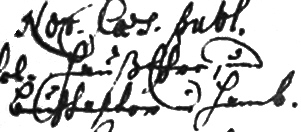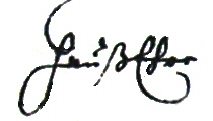Tips and tricks for deciphering old scripts
SpellingWhen we read, we do not spell out the words like a school kid, but recognize the words at a glance and know what is written. When the image of the word is unclear, though, we start to look more closely at the letters. This habit also means that we sometimes misread a word in an old script because we think we recognize the image of the word. Therefore the first rule is: many words in old scripts must be deciphered letter by letter.Normally, one has to "learn" each new style of handwriting. For that reason, it is always useful to have as much text as possible when deciphering old scripts. I often receive only a tiny excerpt with the request to read it. Without the option of comparisons in the same handwriting, this is sometimes impossible! One searches the text for familiar words that are easily legible. How does he write an "e", an "n", or an "r"? What about "sch"? Does he write an arch over the "u"? Can one distinguish between an "h" and an "s"? Can one distinguish between his "s" and his "f"? There were certainly writers whose "h" and "s" looked identical or whose "c" disappeared from "sch".  "Abschieders" (seniors), "Abschieders" (seniors),  "Tischler" (joiner) "Tischler" (joiner)  "Lübsch" (= from Lübeck) "Lübsch" (= from Lübeck)Separate the lines! Often a word is so difficult to read because the loops and arches in the ascenders and descenders cross the next one or even two lines of writing. Think, then, whether the stroke that is troubling you might not belong to the "s" in the line above, etc.  "HaußEhre" is written at the middle of this tangle (see below!). "HaußEhre" is written at the middle of this tangle (see below!).OrthographyWe often cannot read a word in an old script because of the unfamiliar spelling. Forget what you know about German orthography !A baker, in German usually spelled "Bäcker" was former written as "Becker" and "Schmied" (a smith) was written "Schmidt". A "Hufschmied" (a farrier) was therefore written as "Huffeschmidt". A "Bauernvogt" (village mayor) could also be written as "Baurvoigt". I still recall once having a problem with the word "Baurvoigtin". Did such even exist? Yes, because she was the widow of a "Bauernvogt". Sometimes we doubt our reading because we have discovered an unfamiliar occupation: "Zuckerbecker" (sugar baker), "Cattundrucker" (cotton printer), "Wandmacher" (fabric maker, not a wall maker), Schendarm (gendarme), Brenner (burner, means a distiller, not to read Bremer, someone from Bremen), Reuter (a rider, usually spelled Reiter), etc. Similarly, there were unusual terms for acquired rights: Hueffner = Hüffener = Huffener (full farmer), Köthener = Käthner = Viertelhuffener (quarter farmer), Büdner = Bödener = Achtelhuffener (eighth farmer), Brincksitzer (owned a house without property) and the Häuerleute = Miethsleute = Insten (owned neither house nor property). In addition, there were a "Haußwirth" (house owner, today written Hauswirt) and a "Setzwirth" (temporarily set as owner). They were not administered by an "Amt" (office), but written as "Ambt" or "Ampt". In Northern Germany, one must also expect Low German words: Bruer instead of Brauer (a brewer). A great number of surnames were initially Low German and later High German: Steenfatt = Steinfaß, Barckholt = Birckholz, etc. Given names were often abbreviated: Chel instead of Michael, Tietke instead of Matthias, Trin or Trincke instead of Catharina, Make instead of Marquart, Marx instead of Marcus, Radke instead of Conrad, Sille instead of Cecilie (see list of given names). Or they are written in an unusual way: Hanß instead of Hans, Clawes and Clauß instead of Claus, etc. Place names were also often written phonetically and spelled strangely: "Hessenkassel" instead of "Hessen-Kassel".  Expect "o" or "u" to be written instead of "ö" or "ü", or only "k"instead of "ck". An "ß" often looks like "hs", which is then a long -s (similar to an "h") with a round -s behind it. Expect that instead of the expected "K", a "C" was used, and instead of the expected "Z", again a "C". In old texts (17th century), one often finds a "w" instead of "u", which is then pronounced as "u": Frauw, Trittow. Likewise, one finds a "v" instead of "u". Example: "vnnd" means "und".  Lower case lettersIf we can't read one or more lower case letters, we must first check the ascenders and descenders.The letters b, d, f, k, l, t ("t" beginning in the 17th century) have ascenders. The letters f, h, s, ß have ascenders and descenders. The letters g, j, p, q, x, y, z have descenders. When we have a group of letters without ascenders or descenders, they are usually combinations of "e", "r", "n", and "m" (example: "nennen"); in this case, we must count the "legs" of the letters. An "e" should have 2 legs close to each other, but these are often so close that they look like one (thick) leg. An "nn" can also be written as "n" with a line over it, as an "mm" could also be written as "m" with a line over it. A "u" usually looks like an "n"; the "u" is differentiated by an arch above it. This arch is often quite adventuresome; it can hang on the "u" or could be a loop or something that looks like a question mark. NOTE: Some writers do NOT draw an arch over the u, so one must always check each handwriting to see whether the u is written with an arch or without.  "zu" "zu"  "zum" "zum"  "kaufte" "kaufte"  "Jungfer" with arch! "Jungfer" with arch! "Bauer aus" "Bauer aus"  "aus" "aus"That word "Bauer" is difficult to read, because the writer starts the arch at the bottom line and leaves a gap in the word. A "c" and an "i" are easily confused. This is because earlier there was another little arch at the top right of the "c". This is sometimes only indicated by a line or a point (!). The name "geb. Friccius" is a good example of this, and it can also be seen in "Ludowica" and "Michel". See also "Upper case letters".    Also difficult to read are letters with idiosyncratic line formation. Examples: "so", "also", "soll", "gf" in Jungfer (a virgin), "sp" in Kirchspiel (a parish).    Now you might say that these examples were easy to read. True, but I want to get you used to the idea that line formation does not always have to be that to which we are accustomed. When you can't read something, write the word in the air with your finger. Sometimes the writer just took advantage of the "sweep"; sometimes he just wanted to save space. Upper case lettersProblem also come from composite words that have an upper case letter in the middle: HaußEhre (house honor = wife), UnEhre (dishonor), HoffMeister (a name).  "in UnEhren erzeugt" (sired in dishonor)
The "G" almost always causes trouble with upper case letters. The basic rule is: if an upper case letter is absolutely illegible, it is almost certainly a "G"! See also the 6 lines with "G" at Kanzlei2.htm.  "Goldschmied" "Goldschmied"An arch is often on the "C", sometimes even separate from the actual letter : "Cig. Arb" = Cigarren - Arbeiter (cigar worker), "Catharina". This arch also occurs as a vertical line : "Carl".    Do not confuse "L" and "B". A "B" always has "a knot at the belly" that is missing in the "L". One chronicle mentioned a family named "Lohlen" in Reinbek. This was of course the well known surname, "Bohlen".  "Luise" "Luise"  "Braunschweig" "Braunschweig"Do you have other suggestions? Please send me, with example if possible, by email. Thank you ! |
Herzlichen Dank für die Übersetzung an EvaSara Tullier
Compare letters Startpage Suetterlin
Home Guest book eMail
Compare letters Startpage Suetterlin
Home Guest book eMail